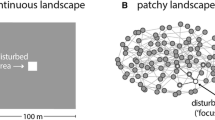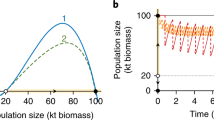ABSTRACT
In this article, we develop a heuristic model of ecosystem-disturbance dynamics that illustrates a range of responses of disturbance impact to gradients of increasing disturbance extent, intensity, or duration. Three general kinds of response are identified and illustrated: (a) threshold response, (b) scale-independent response, and (c) continuous response. Threshold responses are those in which the response curve shows a discontinuity or a sudden change in slope along the axis of increasing disturbance extent, intensity, or duration. The response threshold occurs at a point where the force of the disturbance exceeds the capacity of internal mechanisms to resist disturbance, or where new mechanisms of recovery become involved. Within this conceptual framework, we find that some unusually large or intense disturbances, but not all, produce qualitatively different responses compared with similar disturbances of lesser magnitude. If disturbance impact does not increase with increasing disturbance extent, intensity, or duration, or if the response curve changes monotonically, then large disturbances are not qualitatively different from small ones. For example, jack pine tends to become reestablished after stand-replacing fire in boreal forests, regardless of fire size, because its serotinous cones provide an adequate seed source throughout the burned area. Thus, large fires are not qualitatively different from small fires in terms of jack pine reproduction. However, if disturbance impact does increase abruptly at some point with increasing disturbance extent, intensity, or duration, often because of thresholds in the capacity of internal mechanisms to resist or respond to disturbance impact, then large disturbances are qualitatively different from small ones, at least for some parameters of ecological response. For example, balsam fir and white cedar can recolonize a small burned patch of boreal forest in close proximity to surviving individuals of these species, but they will be eliminated from a large burn because of their susceptibility to fire-caused mortality and their inability to disperse their seeds over long distances. The conceptual framework presented here permits some new insights into the dynamics of natural systems and may provide a useful tool with which managers can assess the potential for catastrophic damages resulting from large, infrequent disturbances.
Similar content being viewed by others
Author information
Authors and Affiliations
Additional information
Received 14 July 1998; accepted 29 September 1998
Rights and permissions
About this article
Cite this article
Romme, W., Everham, E., Frelich, L. et al. Are Large, Infrequent Disturbances Qualitatively Different from Small, Frequent Disturbances?. Ecosystems 1, 524–534 (1998). https://doi.org/10.1007/s100219900048
Issue Date:
DOI: https://doi.org/10.1007/s100219900048




